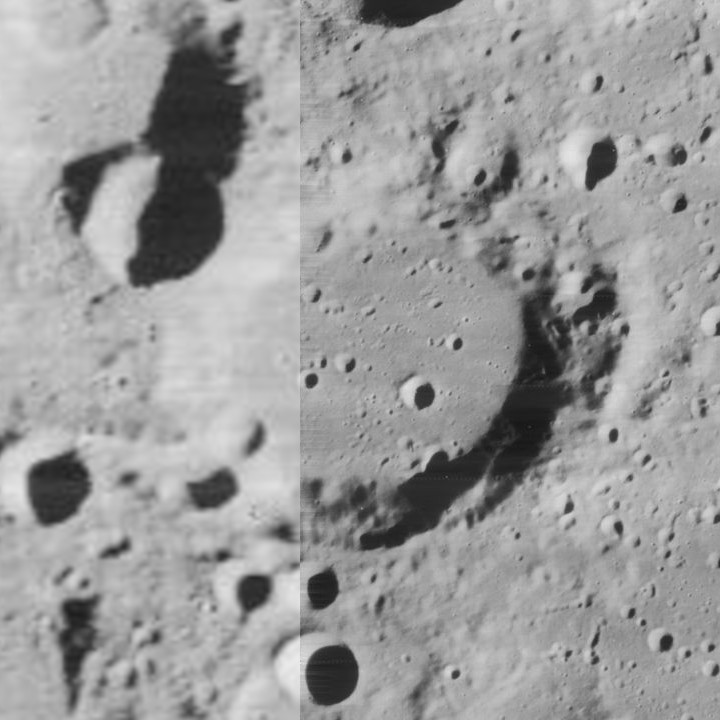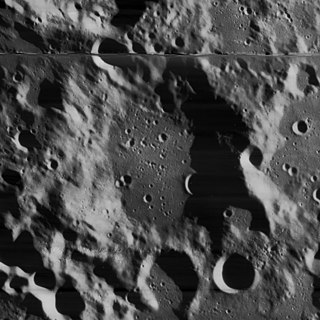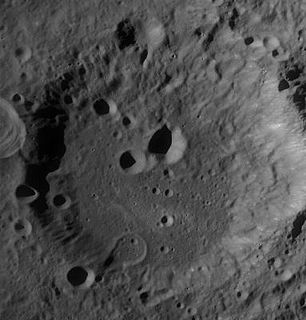
Anaximenes is a low-rimmed lunar impact crater near the north-northwest limb of the Moon. It lies to the west of the crater Philolaus, and northeast of Carpenter. To the northwest is Poncelet, close to the visible edge of the Moon.

Arrhenius is a lunar impact crater that is located just on the far side of the Moon, near the southwest limb. In this location the vicinity of the crater can be viewed during favorable librations, although it is viewed from on edge. To the south-southeast is the worn crater Blanchard, and De Roy lies further to the west.

Dawson is a lunar impact crater that lies on the southern hemisphere on the far side of the Moon. It lies across a crater triplet: the southeast rim is intruding into the crater Alekhin; the northwest rim also intrudes into the larger satellite crater Dawson V, and the northeast rim is attached to the comparably sized Dawson D. To the south of this formation is the large crater Zeeman. West of Dawson is the crater Crommelin, and to the north lies Fizeau.

Birkeland is a lunar impact crater that lies in the southern hemisphere on the far side of the Moon. This crater is attached to the central waist of the oddly shaped Van de Graaff crater formation, and may partly account for that crater's figure-8 shape. To the southeast is the large walled plain Leibnitz.

Hecataeus is a large lunar impact crater that lies near the eastern limb of the Moon. It is attached to the northern rim of the walled plain Humboldt. To the northeast is the smaller crater Gibbs. East of Hecataeus is a chain of small craters forming a line radial to Humboldt; these are designated the Catena Humboldt, named after the walled plain.

Cleostratus is a lunar impact crater near the northwest limb of the Moon. It lies to the northeast of the crater Xenophanes, and west-southwest of the prominent Pythagoras. From the Earth this crater appears highly elongated due to foreshortening.

Chebyshev is a large lunar impact crater that lies in the southern hemisphere on the far side of the Moon. The somewhat smaller crater Langmuir is intruding into the east-southeastern rim of Chebyshev, forming a chain of large craters with Brouwer on Langmuir's eastern rim.

Dyson is a lunar impact crater, 63 kilometers in diameter, that lies on the far side of the Moon, past the northwest limb. It is located in the northern part of the surface, to the northwest of the crater Coulomb, and east of van't Hoff.

Chandler is a lunar impact crater in the northern hemisphere, on the Moon's far side. It lies to the southeast of the large walled plain D'Alembert, and southeast of the slightly smaller Chernyshev crater.

Comstock is a lunar impact crater that is located on the far side of the Moon. It lies to the northeast of the walled plain Fersman, and north of the crater Weyl.

Fourier is a lunar impact crater that is located in the southwestern part of the Moon's near side, just to the southeast of the crater Vieta. To the northeast is the Mare Humorum. The rim of this crater is roughly circular, but appears oval when viewed from the Earth due to foreshortening.

Wilson is a lunar impact crater that lies in the southern part of the Moon's near side, to the southwest of the large walled plain Clavius. It is nearly attached to the southeastern rim of the slightly larger crater Kircher. Almost due east lies Klaproth, another walled plain.
Hédervári is a lunar impact crater that is located in the southern part of the Moon, only a few crater diameters from the south lunar pole. It is attached to the northern rim of the larger crater Amundsen, and lies south of Hale. Due to its location, this crater is viewed nearly from the edge from Earth, which hinders the amount of detail that can be observed. It is also illuminated obliquely by the Sun, and the interior is often cloaked in shadows.

Donner is a lunar impact crater on the far side of the Moon. It is located just to the northeast of the Mare Australe, behind the southeastern limb of the Moon. During favorable librations this part of the lunar surface can be brought into view of the Earth, but the site is viewed from the edge and so not much detail can be seen.

Frost is a lunar impact crater that is attached to the southern rim of the walled plain Landau, and lies on the far side of the Moon. Just to the east is Petropavlovskiy, and to the northeast along the edge of Landau is Razumov. The crater Douglass is located less than a crater diameter to the west-southwest.

Isaev is a lunar impact crater on the far side of the Moon. It is entirely contained within the much larger walled plain Gagarin, and lies in the northwestern part of Gagarin's interior floor. The northwestern outer rim of Isaev is attached to the inner rim of Gagarin.

Koch is a crater on the far side of the Moon. It lies in the southern hemisphere, to the south-southeast of the walled plain Jules Verne. Attached to the northeastern rim of Koch by a neck of uneven terrain is the crater Lundmark. Less than one crater diameter to the south of Koch is Crocco.

Lebedinskiy is an impact crater on the far side of the Moon. It is attached to the eastern outer rim of the somewhat larger crater Zhukovskiy. About two crater diameters to the east-southeast lies the smaller Engel'gardt. The satellite crater Lebedinskiy P lies in the southern indentation of terrain between Lebedinskiy and Zhukovsky, and is nearly attached to the southwest rim of Lebedinskiy.

Vening Meinesz is a lunar impact crater on the far side of the Moon. The northern inner wall of this crater lies along the lunar equator. To the north of this formation is the larger crater Mandel'shtam, and slightly farther to the south is the larger Keeler. Dewar is located less than one crater diameter to the southeast of Vening Meinesz.

Mitra is a lunar impact crater that is attached to the western outer rim of the larger crater Mach, on the far side of the Moon. Just to the west of Mitra is Bredikhin, and to the south-southeast lies Henyey. It is named after Sisir Kumar Mitra.

























